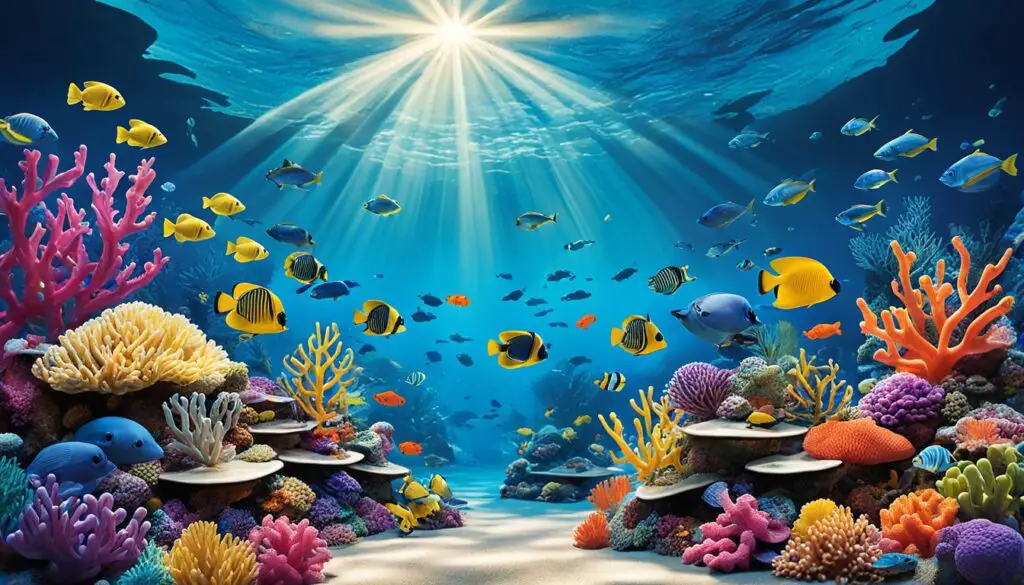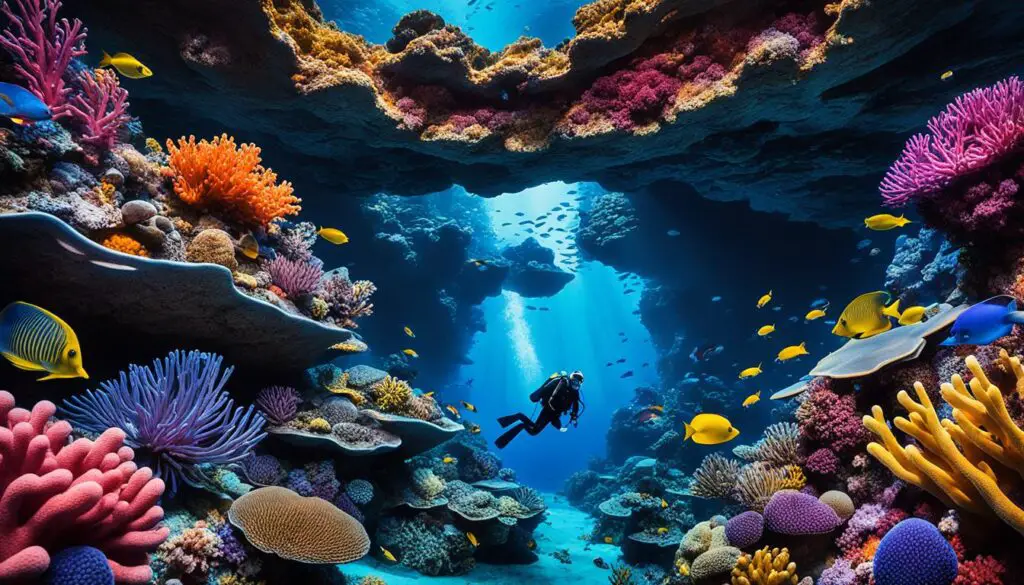Underwater landscape photography is a mesmerizing art form that allows photographers to capture the beauty of the deep. It is a unique genre that requires specialized equipment and techniques to capture stunning imagery beneath the surface. In this article, I will take you on a journey into the world of underwater landscape photography, showcasing the beauty and challenges of this captivating art form.
Key Takeaways:
- Underwater landscape photography offers a whole new world of beauty to explore and capture.
- Challenges in underwater landscape photography include the lack of natural light and distortion caused by water.
- The right techniques and gear, such as underwater housings and strobes, can help overcome these challenges.
- A passion for exploration and a strong understanding of marine ecosystems are essential for capturing the essence of underwater landscapes.
- By embracing the challenges and immersing ourselves in this unique environment, we can create awe-inspiring images that transport viewers to the depths of the ocean.
The Beauty of Underwater Landscapes
Underwater landscapes offer a whole new world of beauty to explore and capture through photography. With vibrant colors, intricate coral reefs, and fascinating marine life, these landscapes provide endless opportunities for photographers to create breathtaking images. From sunken ships to captivating rock formations, underwater environments offer a sense of wonder and mystery that cannot be replicated on land.

Immersing yourself in the beauty of the deep allows you to witness stunning scenes that many people never get to experience. The vivid blues, greens, and purples of the water create a mesmerizing backdrop for the colorful fish, coral, and plant life that thrive beneath the surface.
“Underwater landscapes are like hidden treasures, waiting to be discovered and shared with the world. Each dive reveals a new paradise, a new opportunity to capture the magic of the deep.”
Photographers who specialize in underwater landscape photography have the chance to showcase the intricate details and unique features of these submerged worlds. By capturing the play of light through the water and the delicate movements of marine life, photographers can transport viewers to another dimension.
Whether it’s the ethereal beauty of a vibrant coral reef, the haunting presence of a shipwreck, or the awe-inspiring scale of an underwater cave system, the diversity and grandeur of underwater landscapes are truly remarkable.
Preserving the Beauty for Future Generations
Underwater landscapes are not just visually stunning but also environmentally crucial. They provide essential habitats for a wide range of marine species and contribute to the overall health of our oceans. By documenting and raising awareness of these delicate ecosystems, underwater photographers play a vital role in conservation efforts.
Understanding the beauty and fragility of underwater landscapes compels us to protect and preserve them for future generations. Through the medium of photography, we can capture and share the wonders of the deep with the world, encouraging empathy and action to ensure the longevity of these breathtaking environments.
Challenges and Techniques in Underwater Landscape Photography
Underwater landscape photography presents a unique set of challenges that photographers must overcome to capture stunning images. These challenges include a lack of natural light, distortion caused by water, and the need for specialized equipment. However, with the right techniques and gear, photographers can navigate these obstacles and showcase the breathtaking beauty of the underwater world.
The challenges:
- The lack of natural light poses a significant challenge for underwater landscape photography. As light travels through water, it loses intensity and changes color, resulting in lower visibility and less saturated colors. Photographers must adapt to this limited light source and often rely on artificial lighting, such as strobes or continuous lights, to illuminate their subjects.
- The distortion caused by water is another obstacle that photographers face. Water refracts and scatters light, causing image distortion and reducing image sharpness. To combat this, photographers employ techniques like shooting from a closer distance, using wide-angle lenses, and ensuring proper focus and composition.
- The need for specialized equipment is essential in underwater landscape photography. Underwater housings, designed to protect cameras from water damage, are a crucial investment for photographers. These housings allow photographers to submerge their cameras and capture images with precision and control in the underwater environment.
- Buoyancy control and water currents are additional challenges that photographers must navigate. Underwater photographers need to maintain stability, control their movements, and adapt to the ever-changing water conditions to capture sharp and clear images. It requires skillful buoyancy control and an awareness of water currents to achieve desired results.
The techniques:
- Using wide-angle lenses is a popular technique in underwater landscape photography. These lenses capture a broader field of view, allowing photographers to include more of the underwater landscape in their compositions. Wide-angle lenses also help overcome distortion and enhance depth perception, resulting in more compelling images.
- Strategic positioning is crucial for underwater photographers. By finding the right angle and perspective, photographers can showcase the unique features of the underwater landscape. This could involve shooting from below to capture the sun’s rays penetrating the water’s surface or positioning oneself at eye level with marine life to capture intimate and engaging shots.
- Mastering underwater lighting is essential to overcome the lack of natural light underwater. The use of external strobes or continuous lighting can help illuminate subjects and restore colors lost in the underwater environment. Proper positioning and adjustment of the lighting equipment is important to achieve a balanced and visually appealing result.
- Post-processing techniques can enhance the visual impact of underwater landscape photographs. Adjusting white balance, tonal corrections, and enhancing contrast can bring out the vibrant colors and details that may be lost due to water distortion.
With these techniques and a firm understanding of the challenges posed by underwater landscape photography, photographers can capture mesmerizing images that reveal the beauty and wonders of the deep. The skillful balance of technical expertise and artistic vision is key to showcasing the underwater world in all its glory.

The Dive Into Underwater Landscape Photography
Underwater landscape photography is not for the faint of heart. It requires a deep passion for exploration and a love for the vastness of the ocean. To truly capture the essence of underwater landscapes, photographers must be comfortable in the water and have a strong understanding of marine ecosystems.
Immersing ourselves in this unique environment allows us to witness the fragile beauty that lies beneath the surface. It is in this realm of the unknown that we discover awe-inspiring rock formations, vibrant coral reefs, and mesmerizing marine life. With every dive, we become part of a world that is both captivating and humbling.
Embracing the challenges that underwater landscape photography presents is crucial. The lack of natural light, the distortion caused by water, and the need for specialized equipment can be overwhelming. However, with determination and the right techniques, we can capture images that transport viewers to the depths of the ocean, evoking a sense of wonder and appreciation for this incredible ecosystem.
FAQ
What is underwater landscape photography?
Underwater landscape photography is a genre of photography that captures the beauty of the marine environment beneath the surface. It involves capturing vibrant colors, intricate coral reefs, and fascinating marine life in stunning images.
What makes underwater landscapes unique?
Underwater landscapes offer a whole new world of beauty to explore and capture. With their vibrant colors, intricate coral reefs, and fascinating marine life, these landscapes provide endless opportunities for photographers to create breathtaking images that showcase the wonders of the deep.
What challenges are involved in underwater landscape photography?
Underwater landscape photography comes with its fair share of challenges. The lack of natural light, distortion caused by water, and the need for specialized equipment all add complexity to the process. Photographers must also navigate buoyancy control and water currents to ensure stability and clarity in their shots.
What equipment is needed for underwater landscape photography?
Underwater landscape photography requires specialized equipment, including underwater housings, wide-angle lenses, and strobes. These tools help photographers capture the beauty of underwater environments and overcome the challenges posed by the underwater conditions.
Do photographers need to be scuba certified for underwater landscape photography?
While scuba certification is not a requirement for underwater landscape photography, it is highly recommended. Being scuba certified allows photographers to comfortably explore the depths and capture the essence of underwater landscapes without limitations.
